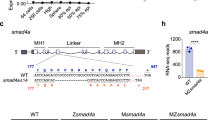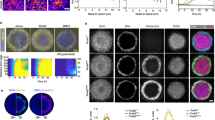Abstract.
Vertebrate embryonic patterning requires several conserved inductive signals–including Nodal, Bmp, Wnt and Fgf signals. Nodal, which is a member of the transforming growth factor β (TGFβ) superfamily, activates a signal transduction pathway that is similar to that of other TGFβ members. Nodal genes, which have been identified in numerous vertebrate species, are expressed in specific cell types and tissues during embryonic development. Nodal signal transduction has been shown to play a pivotal role in inducing and patterning mesoderm and endoderm, and in regulating neurogenesis and left-right axis asymmetry. Antagonists, which act at different steps in the Nodal signal transduction pathway, have been shown to tightly modulate the inductive activity of Nodal.
Similar content being viewed by others
Author information
Authors and Affiliations
Corresponding author
Additional information
Received 20 October 2005; received after revision 15 November 2005; accepted 25 November 2005




